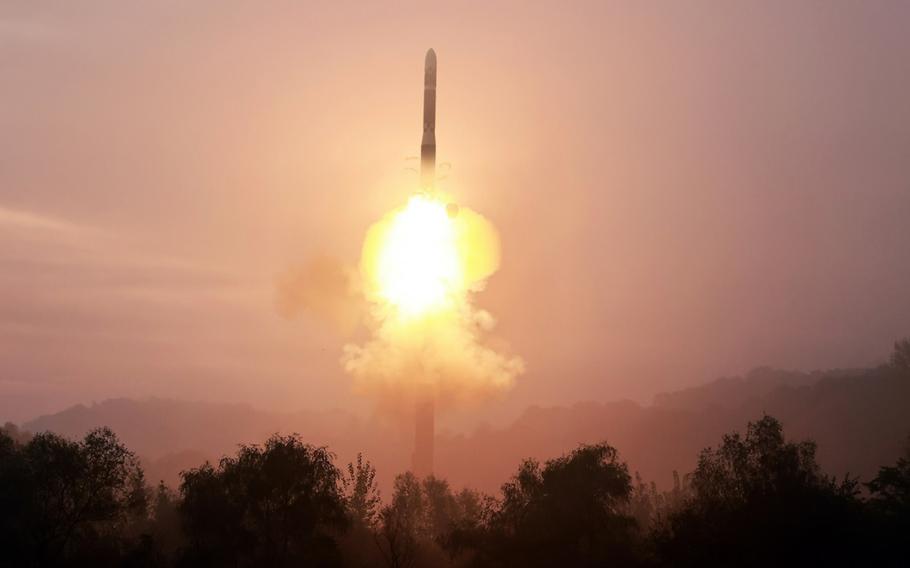
North Korea launches a Hwasongpho-19 intercontinental ballistic missile on Oct. 31, 2024, in this image from the state-run Rodong Sinmun newspaper. (Rodong Sinmun)
CAMP HUMPHREYS, South Korea — North Korea’s intercontinental ballistic missile launch on Thursday achieved a “milestone” in the country’s defense program, according to the state-controlled Korean Central News Agency.
The ICBM, called the Hwasongpho-19, flew 620 miles at a peak altitude of 4,776 miles, breaking the record of prior North Korean missiles, KCNA reported Friday. The communist regime’s previous ICBM launch — a Hwasongpho-18 fired Dec. 18 — flew a similar distance but reached an altitude of 4,050 miles, KCNA reported at the time.
Both ICBMs were launched at a lofted angle. Military analysts have said the Hwasongpho-18 could theoretically reach the U.S. mainland if fired at a standard angle.
Despite the distance, North Korea has yet to show that its ICBMs can carry a functioning warhead, Yang Uk, a research fellow at the Asan Institute for Policy Studies in Seoul, told Stars and Stripes by phone Friday.
The new ICBM appears to have improved first- and second-stage rockets compared to the Hwasongpho-18. However, North Korea has yet to successfully test a missile with a payload the size and weight of a warhead that will affect its trajectory and reentry, Yang said.
The South Korean and Japanese militaries’ estimates of the Hwasongpho-19 were close to KCNA’s claims. Japanese Defense Minister Gen Nakatani said the missile reached an altitude of more than 4,350 miles before falling into the sea between the two countries and South Korea’s Joint Chiefs of Staff said it flew a distance of roughly 620 miles.
The successful launch illustrates Pyongyang’s “absolutely irreversible” goal of improving its nuclear weapons capabilities, KCNA reported Friday.
North Korean leader Kim Jong Un and his daughter, Kim Ju Ae observed Thursday’s launch, which KCNA described as the “world’s strongest strategic missile.”
The White House in a statement Thursday condemned the ICBM test as “a flagrant violation” of U.N. Security Council resolutions. North Korea has been prohibited from conducting ballistic missile tests by the council since 2016.
The launch “needlessly raises tensions and risks destabilizing the security situation in the region,” National Security Council spokesman Sean Savett said in the statement.
The ICBM was fired just hours after Defense Secretary Lloyd Austin and his South Korean counterpart, Kim Yong Hyun, met Wednesday in Washington, D.C. The two defense chiefs confirmed that roughly 10,000 North Korean troops were deployed to Russia to support Moscow’s war against Ukraine.
Russian President Vladimir Putin “will not prevail in Ukraine even with more help from North Korea, but these deeply concerning developments only underscore the importance of our alliance with [South Korea] and other allies,” Austin said at a news conference Thursday.
The U.S. expects to see North Korean troops in combat against Ukrainian forces “in the coming days,” Secretary of State Antony Blinken said at a news conference Thursday after he and Austin met with their South Korean counterparts in Washington.
Asked if North Korea’s latest ICBM test involved newly acquired Russian technology, Kim Yong Hyun told reporters Thursday that no evidence yet supports that theory.
North Korea sending troops to Russia prompted the South to send a military delegation for discussions with European leaders at NATO’s headquarters in Brussels on Monday, according to the Ministry of Foreign Affairs. South Korean President Yoon Suk Yeol has also said Seoul would revisit the possibility of supplying Ukraine with lethal weapons, rather than just humanitarian aid.